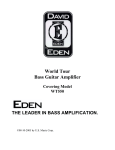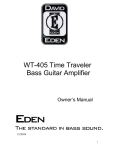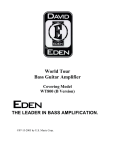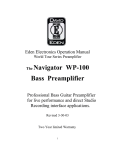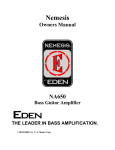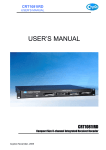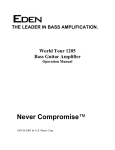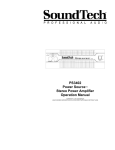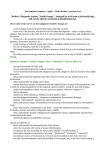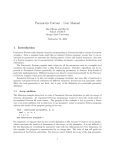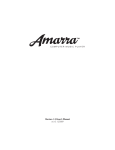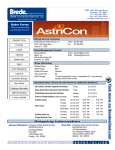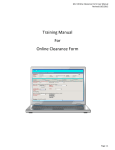Download DC-210XLT Metro 2003
Transcript
Eden Electronics Operation Manual World Tour Series Amplifiers EDEN METRO TWIN CHANNEL BASS GUITAR AMPLIFIER The DC-210XLT Combo OWNERS MANUAL 2-18-03 Rev. A 1 Foreword Congratulations on your purchase of the New Eden David series Bass Guitar Combo Amplifier by Eden Electronics. We are proud to present our very best high power Combo Amplifier. This Amplifier represents a great deal of research and design effort. We have put our best cutting edge amplifier technologies, enclosure design and styling together to create a great sounding Bass head with some wonderful new features. All of this a driven by a monster 600 Watt RMS power Amplifier. CAUTION! Your ears are your most important piece of equipment. Unfortunately, they cannot be replaced as easily as your other gear. Please take the following warning seriously. This product, when used in combination with a sound source and loudspeakers or headphones, may be capable of producing sound levels that could cause permanent hearing loss. DO NOT operate at high volume levels or at a level that is uncomfortable. DO NOT place your ears next to the speakers. If you experience any discomfort or ringing in the ears or suspect hearing loss, you should consult a health care professional. Please complete for your records: Date of Purchase: __________________________ Model: ___________________________________ Serial Number: _____________________________ Dealer: ___________________________________ 2 General Description The DC-210XLT system is 23” x 21 ½” x 18 ”. It weighs only 85 Lbs. The Metro features a one piece aluminum chassis, High efficiency power transformer, Dual channels, thermostatically controlled fan, automatic limiter, a high temperature Auto-limiting system, and international power supply voltages are available on every model. The Output Power of the 600 Watts RMS @ 2 Ohms, 400 Watts RMS @ 4 Ohms, and 240 Watts @ 8 Ohms output at full power. The THD is less than .02%. The Metro also features a hybrid preamplifier consisting of a 7025 vacuum tube with Bi-Fet op-amps and overall modular construction. Other professional features include: Fan cooling, Dual effect loops, Dual channel selected D.I., Front end compressors for each channel, Enhance Control, Three Band E.Q. with semi parametric E.Q. on channel (1), 5 band tone on channel (2), Compressor Bypass, input pad, Tune to Mute, internal speaker on/off switch and Stereo Head Phones. The unit carries a two year limited Warranty. Always use an authorized service center or the factory if you ever have a problem with your unit. If you have any questions about the operation of your unit, please call us at Customer Service and ask for technical assistance @ 847-949-0444. Description of the Front Panel Controls Channel (1) Input Jack Channel (1) The input signal is inserted here for normal operation. Because of the wide level range available from our special input and gain circuitry, only one input jack is required for both passive and active instruments. Channel (1) Operating Characteristics The number (1) channel is an all Bi-FET channel with a smooth crisp sound and a simple easy to use and very pleasant sounding three band E.Q. section. 3 Gain Control The gain control is used to match the output level of your instrument to the proper operating level for the Amplifier and Compressor Limiter. For normal operation you should set the control between 10:00 and 1:00, unless you have an unusually high signal output Bass or a very low output Bass. Input Pad To activate the –12dB pad on the input of your unit pull out on the Gain Control for the channel that you are using, both channels are equipped with this feature. This should only be used for instruments with extremely high output signals. Level set light This is the Green LED indicator located next to the Gain Control. It should be set to blink on the peaks for normal operation. In hard playing conditions it will come on more or less depending on how high the gain is set. If the compressor bypass switch is engaged the LED will come on more often in hard playing conditions. Compressor and the Compressor Bypass Switch This switch allows you to bypass the front end Compressor/Limiter. The Compressor/Limiter in your unit is a fixed threshold type. You adjust the Compression level by turning the gain control up or down until you get the amount of compression you want. You may find that the bypass switch is useful for getting that maximum punch when you are slapping or popping very hard. Enhance Control The Enhance control is a complex tone shaping pre-set. It is designed to boost the lower Bass frequencies, to scoop out the low midrange, and boost the high end up all at the same time. The control is designed to give you a very quick and simple way to get a good quality modern Bass tone. 12:00 is considered to be about the maximum effect on this control and minimum is off. This can be blended with the other controls to create many unique sounds. Mute to Tune 4 When this switch (WORKS ONLY WITH THE FOOT SWITCH ) is engaged ,it mutes both the stage sound and the D.I. send. Only the tuner output stays hot. The Mute is on or muted when the foot-switch LED is on (on those foot switches with LED’s). Or the LED’s on the channel selector are both unlit. Three Band Tone Controls The main tone control section is a simple Three Band tone equalizer. It divides the audio spectrum into three bands: Low, Midrange, and High. The Low and High filters are shelving type filters. The Midrange control is a band pass type filter. This control gives you a broad general control of the tone shaping. Channel Selector operation The Channel Selector switch can be operated from either the front panel or from the foot switch. The foot switch will override the front panel controls. If you plug your instrument into the channel (2 Master input ) jack you can switch between Channel (1) and (2) tone control sections and use your dual channel selector as a dual tone selector. D.I. Selector The D.I. Output automatically follows the active channel. This D.I. is adjustable from Microphone Level to line level. It is automatically selected for the channel that is in use. The back panel Level Control makes adjusting the level sent to the house P.A. very quick and easy. Channel (2) Main Channel Input Jack Channel (2) The input signal is inserted here for normal operation. If this channel is used alone it is possible to switch the other channel on and off though this jack using the Channel selector. If both channels are in use, the switching will be either one or two. Channel (2) Operating Characteristics This Channel features, a high quality 7025 vacuum tube front end coupled to a versatile five way tone control system complete with Hi and Low shelving filters coupled to a three way Quazi-Parameteric tone control system. 5 Gain Control This controls the available gain to the first preamplifier stage. For normal operation run the input Gain between 9:00 and 2:00 for most instruments. -12 dB Pad Pulling out on the Gain Control knob operates the control and results in a signal reduction of –12dB at the input. Enhance Control This is complex tone shaping network. It is designed to slightly boost the lower frequencies. To scoop out the low midrange and add a boost to the high frequencies all at the same time. The control is designed to give you a quick and simple way to get a good modern Bass tone. The 12:00 position is considered to be maximum effect on this control, and minimum is off. This control can be used alone or with other tone controls. Compressor and the Compressor Bypass Switch This switch allows you to defeat or bypass the front end Compressor/Limiter. The Compressor in your unit is a fixed threshold style compressor. You adjust the amount of compression by turning the gain up or down until you get the desired amount of compressor action that you want. You may find the bypass useful for getting the maximum transients and increased punch when you are popping or slapping. The Main Tone Control Section Bass Control This control operates a shelving type filter that will cut or boost the low bass signal by +/- 15 dB at 30 Hz. The response from this control is flat at 12:00 o’clock. This control gives a very solid feel to the bass. It is very effective on 5, 6 and 7 string Basses. Treble Control 6 The Treble control is also a shelving type filter and cuts or boosts the Treble by +/15 dB. Above 2 KHz. Flat response is at the 12:00 position. Semi-Parametric Equalizer (Quazi-Parametric) A fully Parametric Equalizer has controls for Bandwidth or (Q), center Frequency, and the level of the boost or cut. These filters can be very Difficult to set up correctly. It is very Easy to make a fully Parametric EQ. sound bad. The Quazi-Parametric filter is much less difficult for the User to adjust. We have Pre-set the Q or and width to one octave. The Center Frequency is Adjustable from 40 Hz to 10KHz. The level of boost or cut is +/– 15 dB. There is a bypass switch for the EQ so that it can be used alone, or with the other tone controls. Quasi-Parametric Tone Controls, How They Work Quasi-Parametric controls are much like fully parametric tone controls except that one of the adjustments are fixed and the operator cannot adjust the function. The filters in the Eden DC-500 are adjustable for level up to +/- 15 dB and for center frequency (the pitch where the tone change happens). The bandwidth is fixed so that the filters will interact smoothly and musically. If you put two filters together they will combine for a total of +/- 20 dB. Low Frequency Parametric Filter The Low control will cut or boost frequencies from the deep Bass to the lower midrange as selected by the frequency tuning control directly above it. Frequencies available with this control are from 30 Hz. to 300 Hz. The Low control will cut or boost the selected frequency by up to +/- 15 dB. This control and all of the other controls produce a flat response when they are set at 12:00 o’clock. Midrange Parametric Filter The function of this control is also +/- 15 dB and is similar to the Low control except that it controls the frequencies from 200 Hz. to 2 KHz. This is the range of frequencies that the Human Ear is most sensitive to. This control will let you cut right through the mix if you need to. High Frequency Parametric Filter 7 This control works just like the midrange control with +/- 15 dB of change available. It regulates frequencies between 1.2 KHz and 12 KHz. This control is very effective for bringing out the bright overtones on the bass. E.Q. Clipping Indicator This LED will light up if the signal is clipping any place in the tone control or Preamp section. If this lights up while you are playing it will be necessary to redesign your tone controls or lower you input gain to prevent signal distortion. Master Level Control This control is directly ahead of the output power amplifier. It controls the main stage sound level and the Head Phone outputs. Head Phones The Head Phone jack is provided for practicing and can be used as an additional signal send or slave output as it follows the Master Control. Internal Speaker Switch This turns on and off the internal speaker in the enclosure. It does not turn off the External speaker Jacks, they will always be connected to the amplifier. Mains AC Power Switch This turns your unit on and off. Due to the international voltage selector that your unit is equipped with the AC Mains power switching is placed ahead of the fuse. It is possible for the fuse to be blown and the indicator light to be on. It is set up that way to meet certain European Safety regulations. Always be certain the unit is properly set up for the correct voltage of the country it is being used in. If you have any questions about this, call either the factory or an authorized service center and find out before you attempt to use your unit. If you need to change operating voltages for international travel call ahead and make certain that you know the voltage and line cord required by the country you will be going to. Always have a qualified technician do the voltage changes. The Back Panel Operation 8 Main AC Inlet (IEC standard) This inlet fits a standard computer office machine AC cable interconnect. The Fuse is located just above the plug receptacle. The correct voltage is displayed in the upper left corner of the holder and should read correctly with the rest of the printing on the amplifier. If a fuse blows replace it ONLY WITH THE SAME TYPE AND SIZE. The voltage of operation will be marked on the back of the unit. Speaker Outputs There are (3) speaker outputs provided (3) ¼” jacks. For 4 and 2 Ohm operation we recommend using 14 Gauge or lower wire as they are much more robust than lighter types and will deliver more power to the speakers. The DC-500 power amplifier @ full limit puts out: @ 8 Ohms 200 Watts RMS, @ 4 Ohms 400 Watts RMS, and @ 2 Ohms 600 Watts RMS. Recording Output and Ground Lift The 3 pin XLR jack provides the direct connection for a recording or live P.A. console. It is fully balanced and is controlled by the D.I. level control on the Back panel. The ground lift effects only pin (1) of the XLR and breaks the ground path from that pin to the chassis to reduce ground loop induced hum and noise. Pin 2 is hot. Pre Tone Effects Loop This loop is before the tone controls. The send can be used as an extra signal output without breaking the loop. This loop is a good choice for outboard compressors and limiters. Tuner Output This gives you a place to connect your tuner out of the direct signal path of the Bass. It is always on. Even when the mute is engaged the output stays connected. For Your Safety Always use a correctly grounded outlet for your amplifier. Replace your fuse with only the same size and type of fuse. Your unit has a two year warranty described in the warranty section of your manual. 9 CREATING YOUR SOUND This is what we have found to be the best way to get your sound out of the World Tour amplifiers. Setting the pre-amp to flat Set the Enhance controls to “0” or Min. Set all other tone controls straight up or in the 12:00 position Set the master Volume control to (0) Plug in you bass and speaker and turn on the amplifier. Adjust the Master volume control to around 10:00 then adjust the Gain control to the desired volume (if necessary to adjust the gain control beyond the 12:00 position, turn up the master control). The exception to this is some older passive output Basses (i.e. Fender etc.). They may require the Gain control to be as high as (3:00) to operate correctly. Once the desired volume has been reached, rotate the Enhance control while playing. It is possible for many players to achieve just the right sound by using the control alone. If this adjustment does not provide you with the sound you want, return the Enhance control to “0”. Begin to create the tones you want at the treble end of the tone section first. Rotate the Treble control right or left to the desired high frequency sound. Now begin to build your midrange tones starting at the highest frequencies first. With the upper knob of the High control in the 12:00 position, rotate the lower knob to (the Level control) to the right for a peak in the sound or to the left to produce a cut or dip. While playing your bass, rotate the upper knob right or left to locate the frequency you want to hear more or less of in this range. After locating this frequency, add or subtract frequency volume by rotating the lower knob right or left of “0” position. Follow this procedure for the other 2 parametric controls to finish defining your desired midrange tone. Please note that tone control frequencies overlap. In the event you find more than one frequency you wish to control in one of these ranges, it may be possible to affect one of these frequencies with the overlapping control.) Now recheck your volume to make sure it is still where you want it to be. You can use the Bass control to add or subtract the low frequencies. If you change bass tone you will need to readjust volume. At this time you may want to try adding 10 some of the enhance control to see if this tone gives you more of what you want to hear. To sum things up You will always have the best results creating a great bass tone around the natural tone of your instrument. High quality Bass Amplifier systems like the David Series products are designed to enhance and deliver the natural good qualities of your instrument. If you are playing a bass with extreme tonal qualities (like an upright or a vintage bass), it may be helpful to use an equalizer (EQ) with your bass. The EQ can be installed between the bass and the amplifier or inserted into the Effects Loop of the amplifier. The closer to flat you are on the Tone Controls the more the natural tone of your bass guitar will be able to come through. It will also sound more powerful and dynamic. The golden rule of tone controls is that, “Those who equalize least equalize best.” Use what you need but be careful not to over equalize. Powerful tone controls can create problems as well as solve them. Output Limit Light This LED indicator is located next to the Master Control Level pot. It will come on when the amplifier hits full output power. This should light up on occasion when the amplifier is played hard. It should not be on all the time. Tube Replacement – Tube life varies greatly depending upon use, vibration, and tube quality. It is uncommon for a tube to last less than a year in our circuits. Tube life of several years is not at all uncommon. Symptoms of tube failure include signal loss, distortion, and increased noise. The tube is easily replaced by removing the unit’s cover. Use a genuine Eden 7025 / 12AX7 or equivalent. Always disconnect the power cord from the back of the unit prior to removing the cover. 11 Service – In the event of amplifier malfunction, or questions about your unit’s operating features, you should contact your Dealer, the factory or one of our authorized service centers for assistance. Please call our Customer Service dept. At 1-800-USSOUND (1-800-877-6863) extension 5120 For more information or to obtain a Return Authorization number and instructions for factory returns. Please ship Authorized Returns for service to: Eden Electronics 115 2 nd St. Montrose, MN 55363 Eden Electronics C/O U.S. Music Corp. 444 E. Courtland Rd. Mundelein, IL 60060 (847) 949-0444 (847) 949-8444(fax) [email protected] http://www.eden-eletronics.com CR Eden Div. US Music 444 Courtland Rd., Mundelein, IL 60060 12 Your Favorite Tone Settings__________________________ 13














